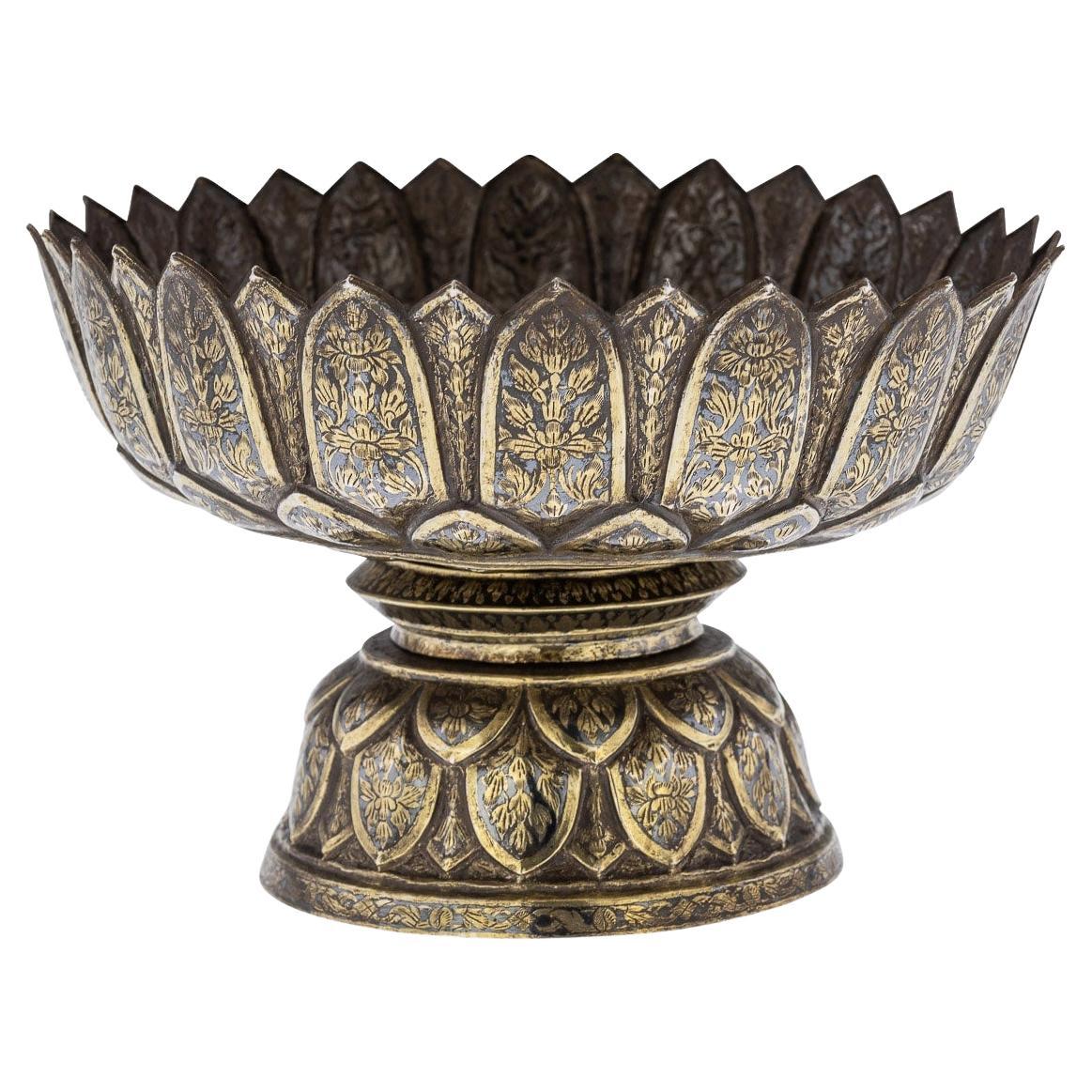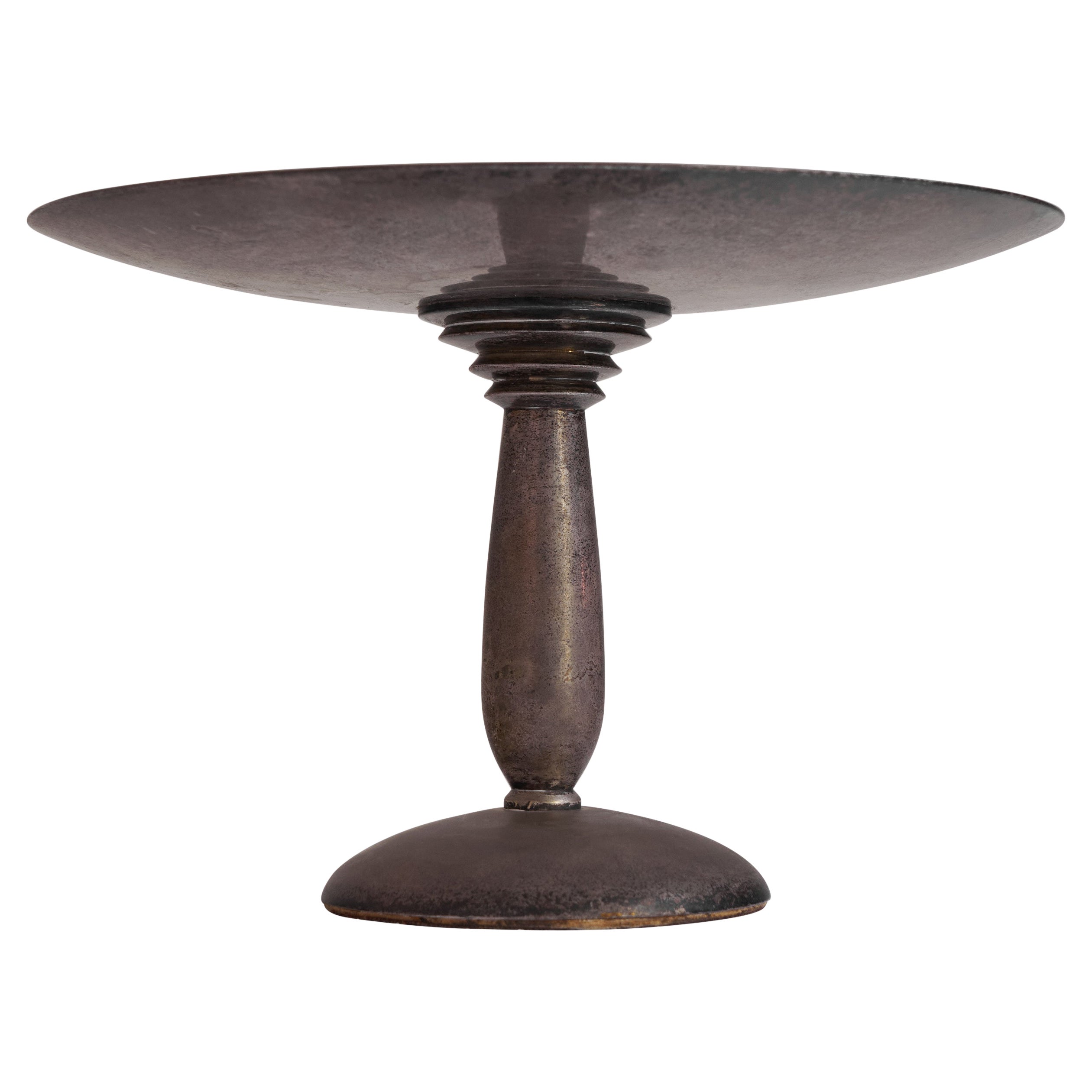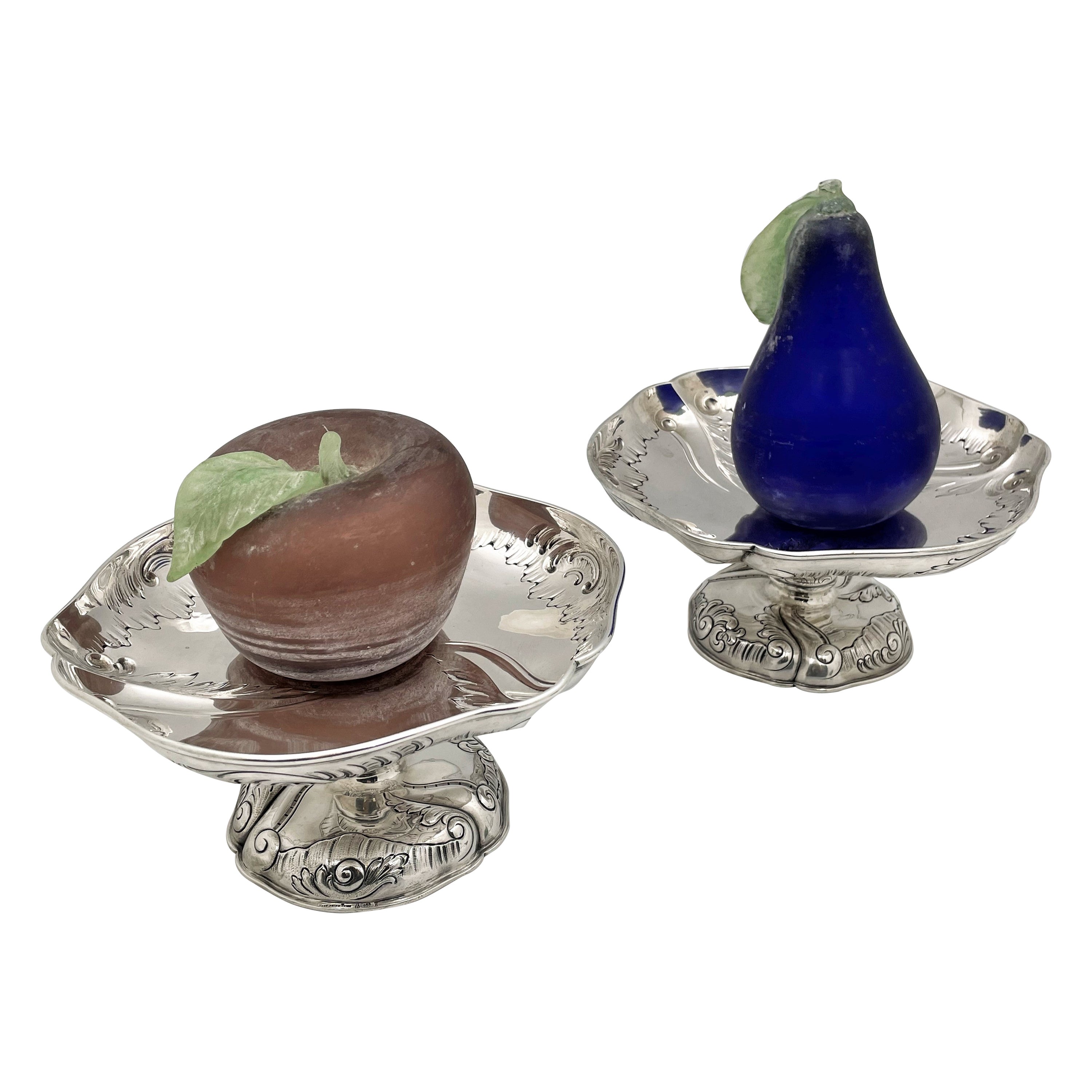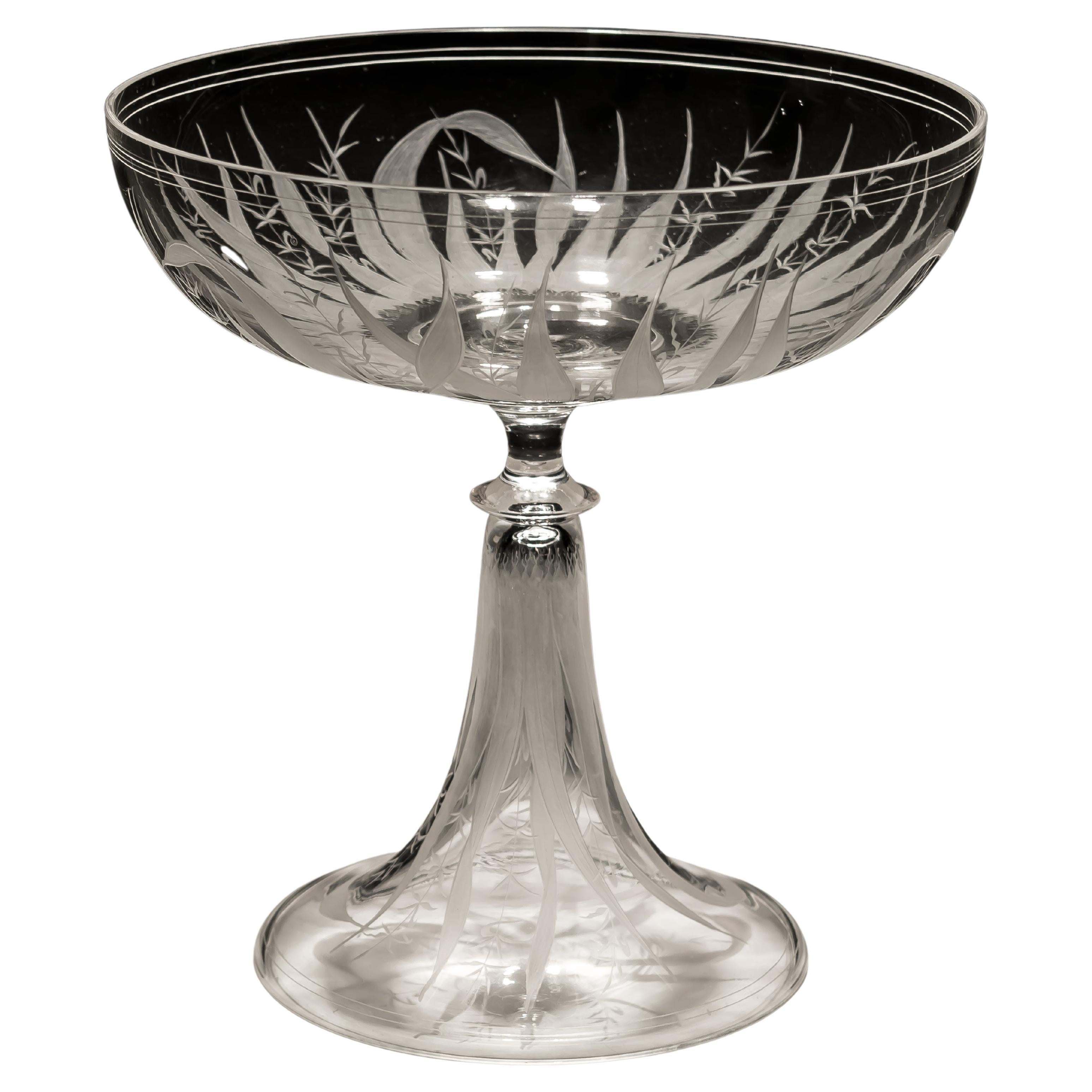Items Similar to Indian Enameled Gem-Set Silver-Gilt Tazza, circa 1800
Want more images or videos?
Request additional images or videos from the seller
1 of 20
Indian Enameled Gem-Set Silver-Gilt Tazza, circa 1800
About the Item
Our magnificent antique gem-set and enameled silver-gilt tazza from northern India, circa 1800, features a lotus form dish decorated with concentric rings of bird, floral and geometrical motifs in green, teal and violet enamel around a central jeweled rosette, with a wasted stand and flaring foot. Weight: 2,400 g; 5 lbs, 5 oz. Bowl turns smoothly on its pedestal base.
- Dimensions:Height: 5 in (12.7 cm)Diameter: 10.5 in (26.67 cm)
- Materials and Techniques:Silver,Enameled
- Place of Origin:
- Period:
- Date of Manufacture:1800
- Condition:Wear consistent with age and use. Minor losses. In good condition with expected bends, dents, nicks and scattered enamel losses and a few losses to the jewels, apparently rock crystal (quartz).
- Seller Location:New York, US
- Reference Number:1stDibs: LU6079232672092
About the Seller
No Reviews Yet
Vetted Seller
These experienced sellers undergo a comprehensive evaluation by our team of in-house experts.
Established in 1990
1stDibs seller since 2021
Typical response time: 1 to 2 days
- ShippingRetrieving quote...Ships From: New York, US
- Return PolicyA return for this item may be initiated within 2 days of delivery.
More From This SellerView All
- German Art Deco Punch Bowl SetLocated in New York, USOur set by Wilhelm von Eiff (1890–1943) includes a large bowl with frosted and carved horizontal bands with domed lid with silver mount, 17 3/4 by 12 1/2 inches, finial showing a young Hercules wrestling a serpent, ladle with Hercules cameo in .800 silver, signed W.V. Eiff, a glass ladle...Category
Early 20th Century German Art Deco Serving Bowls
MaterialsSilver
- Fuset y Grau Indian Style 18K Gold Gem-Set and Diamond BraceletLocated in New York, USOur extraordinary 18k gold, gem-set and diamond bracelet by Fuset y Grau, circa 1930, depicts a ceremonial procession of Indian royalty including riders i...Category
Vintage 1930s Spanish Art Deco Collectible Jewelry
MaterialsMulti-gemstone, Gold
- Cartier Silver and Enamel Picture Frame Circa 1900sBy CartierLocated in New York, USOur lovely and rare silver picture from Cartier dates from as early as the 1900s and features an outer ring of green enamel and its original leather covered and lined gift box.Category
Early 20th Century French Belle Époque Picture Frames
MaterialsSilver, Enamel
- Matched Pair Antique Austrian Silver-Gilt Ewers Circa 1780sLocated in New York, USOur pair of elegant silver-gilt ewers are attributed to the Austrian maker, Johann Georg Hann of Vienna, circa 1780-1800. Heights: 17 7/8 and 22 1/2 in; 45 a...Category
Antique Late 18th Century Austrian Neoclassical Pitchers
MaterialsSilver
- Boucheron Parcel Gilt Silver Vase and Oil Lamp circa 1880By Fréderic BoucheronLocated in New York, USOur important parcel-gilt and patinated silver and glass-mounted vase and matching oil lamp were designed by Paul Legrand (1840-1910) and crafted by the silversmith, Charles Glachant, for Boucheron of Paris, circa 1878-1880. 21 in tall and 16.5 in wide (53.4 by 41.9 cm). 28.56 lbs, 457 oz, 14,210 g. Provenance: presented to or purchased by Jean-Baptiste Pezon (1827-1897); acquired by a European private collector, perhaps on the death of Jean-Baptiste Pezon in 1897, by descent; acquired by YM Antiques, 2017. This double walled vase has an amphora form, with body and foot with silver, gilt and patinated and stylized flowers, anthemions and sprays of cherries against an etched and matted ground pierced to reveal a gilt inner wall. The upper body is detachable via a slip-lock, and mounted on both sides with arched panels formed of hexagonal beveled glass tiles. One glass panel applied with bacchic infants taunting a rearing goat and the other side with infants feeding grapes to a lioness under a looming bust of a satyr. The patinated and gilt upswung loop bifurcated handles are mounted with fully modeled figures of Pan bearing a syrinx and thyrsus and a draped maenad playing two flutes, both above roaring lion heads, the rim inset with a slip-lock detachable gilt bowl etched with masks of various representations of Bacchus spaced by ribbons and trophies and with scrolling fruiting vines. The base of interior with detachable base metal drip pan to accommodate the removable oil lamp designed to illuminate the glass tiles from within. The lamp is raised on four hoof feet, the upturned ends cast underneath with masks and with detachable cover mounted with two infant satyrs and flanked by gilt loop handles. The bacchic themed design featuring cartouches depicting infants taunting a goat and lion, plus prominent lion masks at the handles, certainly appealed to Boucheron's customer, Jean-Baptiste Pezon (1827-1897), who is believed to have commissioned the piece. Pezon was the celebrated lion tamer and headliner of the Grande Menagerie whose profession brought him great fame and fortune in Paris. Born a shepherd boy in Lozere, he is said to have left his home at the age of seventeen in the company of a wolf he had captured and trained years earlier. He headed to Paris and by the age of twenty-one purchased his first lion who he named Brutus. The animal is said to have inspired the Lion of Belfort, the monumental red standstone sculpture by Frederic Bartholdi erected in Belfort in 1880. Toulouse-Lautrec was among his admirers and friends, visiting Pezon's Great Lozerian Menagerie to sketch animals. A large bronze sculpture of Pezon atop a female lion adorns the Pezon family tomb in the Pere Lachaise Cemetery in Paris, as seen in our image here. The vase and detachable bowl are marked on the underside with the silversmith's mark of Charles Glachant. The underside and upper rim of the lower body is engraved "Fic Boucheron Paris". The lamp is marked on underside and flange of cover for Glachant. Boucheron archives indicate the vase was inspired by the amphora vases created by the Greek potter, Nikosthenes, 550-510 BC. The Nikosthenic amphora vases are a form of Attic vase recognized for their angular amphora form with broad flat handles. Potted of bright orange-red clay, they were decorated with plant and animal motifs within distinct friezes, with the most significant defining feature being the black figure painting, often highlighted with white accents. In this vase Legrand re-imagines the striking contrast of the black figures against a warm ground through the use of patina and gilding. His inventive use of piercing and double-wall construction create additional levels of texture and depth throughout the body. The same combination of ornamentation was employed in a ewer designed by Legrand in 1880 in the Islamic taste. (See lot 77 of Christie's sale in New York on October 22, 2009.) Edmé Bouchardon (1698-1762), royal sculptor to Louis XV, may have provided Legrand with inspiration for the vase's iconography. The panel featuring bacchic infants taunting a rearing goat is very similar to a bas relief representation of Winter designed by Bouchardon for the Fontaine des Quarte-Saisons on rue de Grenelle, Paris. Bouchardon debuted his plaster model for the bas relief in 1741, and the fountain was completed in 1745. The Boucheron firm, founded by the celebrated jeweler, Frédéric Boucheron...Category
Antique 1880s French Greek Revival Vases
MaterialsSilver
- Continental Grand Tour Marble TazzaLocated in New York, USOur large neoclassical tazza carved from variegated charcoal colored marble with red and grey dates from the nineteenth century. Provenance: Jay Waldmann, Waldmann Inc., Southampt...Category
Antique Late 18th Century European Grand Tour Centerpieces
MaterialsMarble
You May Also Like
- 19th Century Thai Solid Silver-Gilt Niello Enamel Bowl, Siam, c.1800Located in Royal Tunbridge Wells, KentAntique early-19th Century extremely rare & fine solid silver niello bowl, stylised leaf shaped rim and domed spreading foot, repousse decorated with dense floral gilded ground. Niel...Category
Antique 19th Century Thai Serving Bowls
MaterialsSilver, Enamel
- Russian Silver Gilt and Cloisonné Enamel KovschLocated in London, GBThe silver gilt kovsch decorated in cloisonné enamel with a pattern of leaves and flowers, set with polished gemstones, marks to the underside. The kovsch is a traditional Russian drinking...Category
20th Century Russian Serving Bowls
MaterialsSilver, Enamel
- WMF Art Deco Tazza in Patinated SilverBy WMF Württembergische MetallwarenfabrikLocated in Tilburg, NLWMF Art Deco Tazza in patinated silver. Germany, first half of the 20th century. Elegant and stylish Art Deco tazza / serving dish in patinated silver...Category
Mid-20th Century German Art Deco Decorative Dishes and Vide-Poche
MaterialsMetal, Silver Plate
- 19th Century French Gilt White Opaline Compote / TazzaLocated in West Palm Beach, FL19th Century French gilt white opaline compote/tazza. France, circa 1880 A nice example of 19th century French opaline glass, with the continuous u...Category
Antique Late 19th Century French High Victorian Serving Bowls
MaterialsOpaline Glass
- Pair of Friedlander Royal Maker Continental Silver 19th Century Tazza / BowlsBy Gebruder FriedlanderLocated in New York, NYPair of German, continental silver tazza or footed bowl by prestigious royal maker Gebrüder Friedländer, from the late 19th century, with flowing, stylized, scroll and foliate motifs...Category
Antique Late 19th Century German Rococo Sterling Silver
MaterialsSilver, Sterling Silver
- Fineley Engraved Victorian TazzaLocated in Steyning, West sussexA finely engraved tazza with reeds and rushes.Category
Antique 1880s Tableware
MaterialsCut Glass





